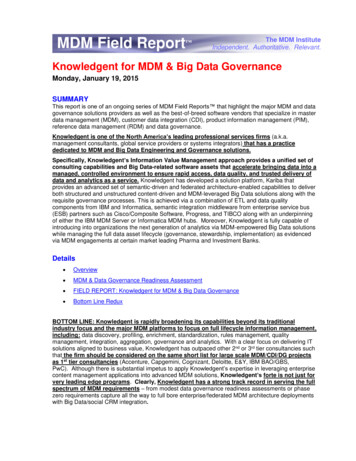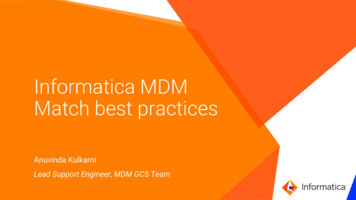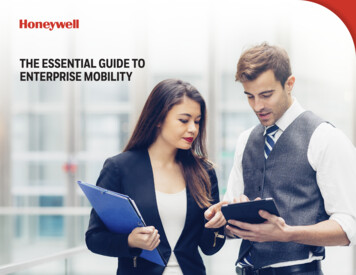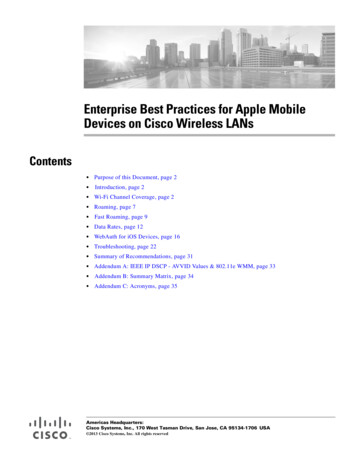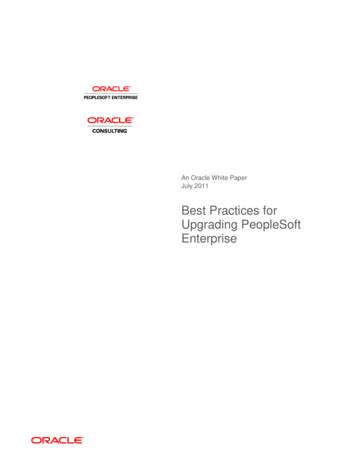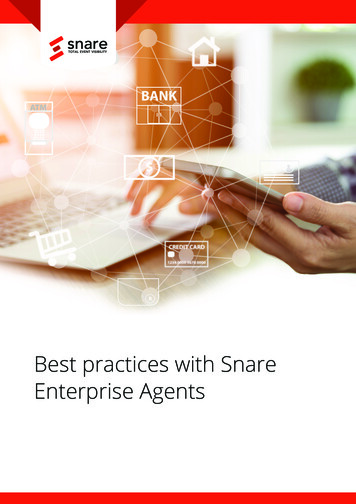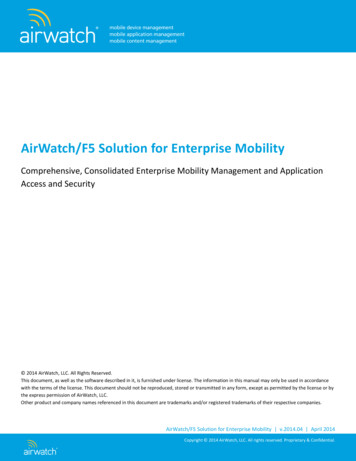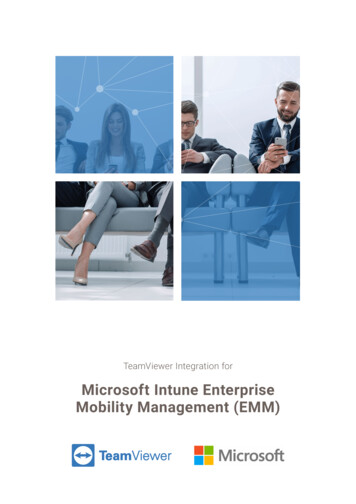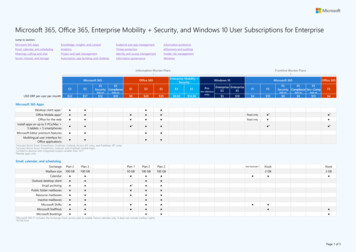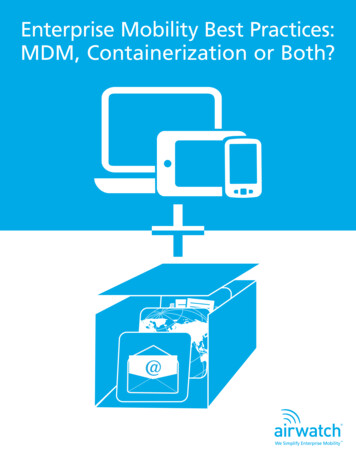
Transcription
Enterprise Mobility Best Practices:MDM, Containerization or Both?
Enterprise Mobility Best Practices:MDM, Containerization or Both?Less than a year ago, analysts’ predictions had mobility enthusiasts believing doomsday was approaching forthe mobile device management (MDM) industry. At the 2013 Gartner Security and Risk Management Summit,a panel of analysts told attendees that the bring your own device (BYOD) phenomenon would lead to slashedprices, plummeting sales and the death of an industry. “Mobile device management is in chaos right now,and I think this market is going to die,” Gartner analyst John Girard told attendees (as reported by CRN.com).Girard predicted a shift toward application-level management necessitated by the BYOD trend and employeeresistance to management of personal devices.In the same panel session, Gartner fellow Neil MacDonald said that the sharpest MDM vendors “know the endis in sight, and they are building containers. They’re building out a mobile application management solutionto start going down that path.” The analysts predicted a paradigm shift, in which CIOs and mobility expertswould drop device-level management entirely, instead choosing more granular management of data andapplications through an encrypted corporate container. Enterprise mobility, they predicted, would focus onmanaging the data, not the device.Today, the market tells a slightly different story. MDM is still the preferred method for BYOD security,according to a Technavio report. As application-level management through containerization has continued togrow in popularity, MDM has kept pace. Rather than replacing one with the other, companies have realizedthat both MDM and application-level management are still relevant for different device deployments, and insome cases, provide additional functionality and security if they coexist together on the same device.Instead of having the MDM vs. containerization debate, enterprises should define device use cases and securityrequirements within the organization, and then decide which solutions best suit their needs. Organizationswith all kinds of deployments – corporate-owned devices, BYOD or a combination of the two – are findingthat MDM and containerization together provide flexibility, user enablement and enhanced security. Manyorganizations are choosing to deploy MDM and containerization together on the same devices, for a layeredapproach to security. Below, we’ll discuss common enterprise use cases and define the advantages of MDM,containerization and the layered approach to security that both can provide.Enterprise Mobility Best Practices: MDM, Containerization or Both?
MDMMDM enables mobile security at the most foundational level: the device itself. With MDM, IT has the abilityto configure advanced device management and monitoring settings through profiles, which can be appliedbased on operating system or device ownership type, enabling enterprises to take more control of corporatedeployed devices. MDM protects data stored on the device or in applications at the device level by prohibitingunauthorized actions, such as attempts to root or jailbreak the device, download malicious applications or installmalware. With AirWatch Mobile Device Management, enterprises can perform device-level actions such as: Enforce data encryption Require a device passcode Remotely reset the passcode Remotely lock the device Enforce device restrictions Track the device’s location Set roaming restrictions to reduce telecom costs Perform an enterprise or device-level wipe Send push notificationsOnce a device is enrolled in AirWatch Mobile Device Management, profiles that have been pre-set bythe administrator based on device type, ownership model or organization group automatically begindownloading. Administrators create profiles from the AirWatch console that push enterprise applications,enable monitoring and enforce automated compliance through the AirWatch compliance engine. If an enduser downloads an application that the administrator has blacklisted, AirWatch can automatically send anotification prompting the user to remove the application. If the application has not been removed aftera pre-set period of time, administrators can set escalating actions that will automatically restrict access toresources such as enterprise content or email until the application is removed. Administrators can also setrestrictions to device features and native applications.Administrators can also limit the time a device remains unlocked without requiring the end-user to re-enterthe passcode, or remotely lock a device that has been lost or stolen. Administrators can apply profiles thatlimit the number of incorrect passcode attempts. After the pre-determined limit has been reached, a pre-setprofile can reset the password or perform an enterprise wipe. Some operating systems offer advanced kioskmodes, silent installation and removal of applications or even remote control.AirWatch integrates with existing directory services, such as Active Directory and LDAP. Administrators canimport existing directory structure to ensure users receive the appropriate access based on organizationgroup, and users can enroll in AirWatch using their existing corporate credentials.Devices in an enterprise deployment can be given different management profiles and access to corporateresources based on job title, region, device ownership and other factors. All devices in an enterprisedeployment can be monitored through a single web-based administrative console, regardless of managementsettings, device type, organization group, language, location or ownership model.Enterprise Mobility Best Practices: MDM, Containerization or Both?
MDM provides some unique benefits over other management models. AirWatch Mobile Device Managementenables employees to automatically connect to corporate Wi-Fi and enterprise VPN networks without userinteraction. AirWatch allows administrators to configure Wi-Fi and VPN profiles to download automatically oron demand to user devices. Profiles can be assigned based on user group, location within a defined geofenceor time of day. For example, if employees should only be accessing Wi-Fi or virtual private networks (VPN)during defined business hours, AirWatch enables IT administrators to set that restriction.AirWatch also provides the ability to provision a VPN profile to devices to automatically configure access tocorporate networks and file systems. The advanced VPN On Demand capability allows mobile users to securelyaccess specific websites through a VPN tunnel. This process is invisible and seamless to the user, allowing themto continue working without interruptions. App-level VPN capabilities for Apple iOS devices now also enableadministrators to connect single apps to the VPN.MDM Use Cases: Corporate-ownedThe device-level approach is a no-brainer for organizations that distribute devices to employees. Managingthe whole device enables organizations to track and maintain a real-time inventory of their assets. Becausecorporate-owned devices are usually dedicated to only corporate use, most enterprises choose MDM for itsadded device-level controls, such as device and enterprise wipe, remote passcode lock, and the ability tomonitor a fleet of devices in real time.MDM also offers organizations the ability to limit telecom expenses. AirWatch enables companies to reducewireless expenses through real-time data monitoring. Administrators can set a profile that automaticallydisables the ability to use data or make calls when a device is roaming.MDM Use Cases: BYODHowever, there is a perception in the market that MDM can be too heavy-handed an approach for devicesthat employees own and use to access corporate content. Both Apple and Windows platforms are built toaccept device-level management, while keeping ultimate control in the users’ hands. Under settings, users cansee all profiles that are installed on the device, so the end user can view what profiles IT has installed on theirdevice. Neither Apple iOS nor Windows platforms allow access to the content of text messages, phone callsor personal email. Administrators cannot read, listen to or record any conversations that take place on thedevice. The more open Android platform does allow additional MDM controls, so many organizations chooseto provide the containerization option on employee-owned Android devices.Many users do not want to give IT the ability to remotely wipe their device because they are afraid of losingvaluable personal content. AirWatch provides a remote enterprise wipe option, which enables IT to wipeonly enterprise content from the device while leaving personal content untouched. To ensure peace of mind,many organizations will choose to deploy enterprise content in a separate corporate container on manageddevices so there is a clearly defined managed space on employee-owned devices. It is ultimately up to theorganization to create a BYOD policy that clearly defines what data the organization collects and monitors.AirWatch recommends BYOD policies that prohibit IT access to personal content. AirWatch also providesorganizations with a set of privacy policies, which can be customized for employee-owned devices.Enterprise Mobility Best Practices: MDM, Containerization or Both?
ContainerizationContainerization offers organizations the ability to securely deploy and manage corporate content in anencrypted space on the device. All corporate resources, including proprietary applications and corporateemail, calendar and contacts reside within this managed space. The password protected container gives usersaccess to all corporate applications through single sign on (SSO), providing a convenient way for users toaccess the managed space. The containerization approach allows IT to not only secure corporate data on adevice, but also control which apps can access data and how that data is shared. If the data is compromised,the entire container or a specific application can be removed remotely.Deploying managed applications outside of an encrypted container opens the data housed within the appsto vulnerabilities because IT cannot control how those applications communicate with other, unmanagedapplications on the device. For example, a secure file sharing app may require a partner application toperform actions such as editing and annotating. If the apps are used together to edit a file, data may becopied from the secure file sharing app to the public cloud of the editing app, thereby leaving IT’s control.AirWatch Secure Content Locker is a secure file sharing container with built-in editing and annotatingcapabilities, so users can perform these actions without data ever leaving the app. AirWatch Inbox is a secureemail container that enables organizations to separate users’ corporate email into an encrypted, managedcontainer. Hyperlinks in files or emails can be restricted to opening in the secure AirWatch Browser. Allapps can be housed in the AirWatch Workspace to enable single sign on. Using AirWatch ApplicationManagement solutions such as the AirWatch Software Development Kit or AirWatch App Wrapping enablesan organization’s internal applications to function securely within AirWatch Workspace.AirWatch Workspace, available for iOS and Android, is a container that can house all enterprise apps ona device, enabling secure access to corporate data – including email, applications and content, a securebrowser and custom applications. Housing applications such as AirWatch Inbox, Secure Content Locker orother enterprise apps in AirWatch Workspace limits those applications to sharing data only with other secure,managed applications. All applications inside the container can be accessed via single sign on.Use Cases: BYODContainerization is commonly referenced as a solution for employee-owned devices. Because it offers amanaged space on the device, employees who want to use their own devices to access corporate content aregenerally more confident that their privacy will be respected, whether they are enrolled in MDM or not.Use Cases: Collaboration in the Extended EnterpriseContainerization also provides a way to share content and applications securely in the extended enterpriseto end users who are not enrolled in MDM. Administrators can deploy a secure container to consultants,contractors, vendors, business partners, board members and other collaborators without managing their devices.AirWatch Workspace can be custom-branded, so users can share documents and data with members of theextended enterprise in a container that is consistent with their corporate identity, rather than one that lookslike a third-party application. By wrapping all enterprise apps and data in AirWatch Workspace, AirWatchenables administrators with added control and heightened security for enterprise data on unmanageddevices. With AirWatch Workspace, corporate data will never leave an organization’s managed networkenvironment, even when it is shared with collaborators in the extended enterprise. Should an unmanageddevice housing corporate data become compromised, AirWatch Workspace enables administrators to performEnterprise Mobility Best Practices: MDM, Containerization or Both?
an enterprise wipe and remove all corporate data with a single action, while leaving personal data intact.A Layered Approach: MDM ContainerizationAs more business processes are extended to mobile, many organizations are finding uses for both MDM andcontainerization, either for different device deployments or on the same device.Different Device DeploymentsAdministrators in large organizations with both corporate-owned and BYOD deployments may want toconsider MDM for corporate-owned devices and containerization for BYOD devices and other use cases thatdo not require device management, such as collaboration in the extended enterprise.MDM and Containerization Deployed on the Same DeviceOrganizations with highly sensitive proprietary content or in strictly regulated industries may prefer theadded security that MDM and containerization on the same device provides. A corporate container deployedon a managed device provides an extra barrier to access corporate content. Users are required to enter both adevice-level passcode and a container-level passcode, and administrators have both device-level controls andapplication-level controls that enable app-to-app collaboration with other managed and secure applicationswithin the container. For example, a link sent in a secure email can be opened in the secure AirWatch Browser,and a sensitive attachment can be opened and edited in Secure Content Locker.MDM and containerization are often thought of as mutually exclusive security solutions, but today’s mostinnovative organizations are taking a layered approach to security by using the two in conjunction. Within anenterprise, IT can choose to adopt a hybrid model with several different management approaches. This maybe necessary if some devices in your organization are corporate-owned devices, while others are employeeowned devices. For enterprises that have both BYOD and corporate-owned devices, administrators can stilleffectively monitor and manage devices that are secured through MDM, containerization or with bothtogether in a single, integrated platform.A Complete, Integrated Platform for MobileEach solution in the AirWatch Enterprise Mobility Management Platform has been built from the groundup, with the same security framework at the core. The administrative console enables a bird’s-eye view of alldevices in a deployment. Whether devices are managed through MDM or containerization, IT administratorscan manage the entire deployment through a single pane of glass from AirWatch’s web-based console.Making it simple to manage and enable devices across the enterprise is what AirWatch is known for. Asingle platform for all mobile needs means simplified management, and simpler management means ITadministrators are more likely to catch potential security breaches before they become major issues.Business use of mobile devices is becoming more strategic and use cases are getting more complex.Enterprises are continually adding users and deploying content and applications in the extended enterprise.If an organization truly wants to scale, it is imperative to find an enterprise mobility management solutionthat was built using the same architecture on a single platform. AirWatch offers an integrated mobileplatform for managing content and collaboration, as well as securing applications, browsing and email inEnterprise Mobility Best Practices: MDM, Containerization or Both?
the extended enterprise. AirWatch also leverages organizations’ existing infrastructure to enable access tocorporate resources. AirWatch ensures the value of IT investments in VPN, Wi-Fi security, SharePoint and othercontent repositories, as well as enterprise resource planning (ERP) and customer relationship management(CRM) systems. By extending these resources to mobile, AirWatch both extends security and enables employeeproductivity through mobility.When selecting an enterprise mobility platform, organizations should not only look at current mobile needsbut also consider an extended roadmap that includes any future plans to develop apps, extend more businessprocesses to mobile or expand collaboration with the extended enterprise. To prepare for a mobile-centricworld, organizations today need a platform that is flexible, that scales, and that they can grow into asopposed to growing out of.Whether enterprises choose MDM, containerization or a layered approach, AirWatch has created a platformthat allows both enablement of business processes and the security that IT departments require, with afriendly user interface, deep enterprise integration and the flexibility to collaborate and grow.Enterprise Mobility Best Practices: MDM, Containerization or Both?
Additional ResourcesFor additional information, tainerizationTo get started with a free trial of AirWatch, visit www.air-watch.com/free-trial.AirWatch Global Headquarters1155 Perimeter Center WestSuite 100 Atlanta, GA 30338United StatesT: 1 404 478 7500E: sales@air-watch.comAbout AirWatchAirWatch is the largest Enterprise Mobility Management provider in the world with over 1,600 employeesglobally. More than 10,500 companies trust AirWatch to secure and manage their mobile enterprise. Withmarket-leading solutions for mobile security, device, email, application, content and browsing management,we simplify enterprise mobility.Enterprise Mobility Best Practices: MDM, Containerization or Both?
Management solutions such as the AirWatch Software Development Kit or AirWatch App Wrapping enables an organization’s internal applications to function securely within AirWatch Workspace. AirWatch Workspace, available for iOS and Andr
